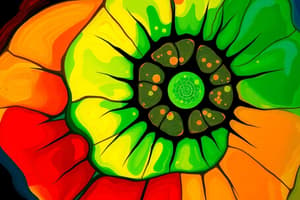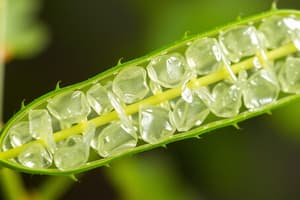Podcast
Questions and Answers
Which of the following is the MOST accurate overall description of photosynthesis?
Which of the following is the MOST accurate overall description of photosynthesis?
- The conversion of glucose and oxygen into carbon dioxide and water using chlorophyll.
- The breakdown of glucose into energy, carbon dioxide, and water.
- The process of plants absorbing nutrients from the soil.
- The conversion of carbon dioxide and water into glucose and oxygen using light energy. (correct)
Which of the following structures is the site of the light-dependent reactions in photosynthesis?
Which of the following structures is the site of the light-dependent reactions in photosynthesis?
- Granum (correct)
- Stroma
- Cell Wall
- Chloroplast DNA
What are the direct products of the light-dependent reactions that are subsequently used in the Calvin cycle?
What are the direct products of the light-dependent reactions that are subsequently used in the Calvin cycle?
- ATP and NADPH (correct)
- Glucose and Oxygen
- Carbon Dioxide and Water
- Starch and Chlorophyll
In the chemical equation for photosynthesis, what does C6H12O6 represent?
In the chemical equation for photosynthesis, what does C6H12O6 represent?
Which of the following BEST describes the role of photosynthesis in the carbon cycle?
Which of the following BEST describes the role of photosynthesis in the carbon cycle?
How does increasing light intensity typically affect the rate of photosynthesis, assuming other factors are not limiting?
How does increasing light intensity typically affect the rate of photosynthesis, assuming other factors are not limiting?
What is the MOST likely effect of a significant increase in temperature above the optimum level on the rate of photosynthesis?
What is the MOST likely effect of a significant increase in temperature above the optimum level on the rate of photosynthesis?
In an experiment testing the necessity of light for photosynthesis, why is the plant typically placed in darkness for 48 hours prior to the experiment?
In an experiment testing the necessity of light for photosynthesis, why is the plant typically placed in darkness for 48 hours prior to the experiment?
Which of the following industrial applications directly benefit from understanding the factors affecting photosynthesis?
Which of the following industrial applications directly benefit from understanding the factors affecting photosynthesis?
What is the role of ATP in the light-independent reactions (Calvin cycle) of photosynthesis?
What is the role of ATP in the light-independent reactions (Calvin cycle) of photosynthesis?
If a plant is exposed to a constant high light intensity but the rate of photosynthesis does not increase, which of the following is the MOST likely limiting factor?
If a plant is exposed to a constant high light intensity but the rate of photosynthesis does not increase, which of the following is the MOST likely limiting factor?
How do greenhouses leverage the environmental factors affecting photosynthesis to enhance crop yields?
How do greenhouses leverage the environmental factors affecting photosynthesis to enhance crop yields?
Considering the environmental impacts of photosynthesis, how does it contribute to mitigating global warming?
Considering the environmental impacts of photosynthesis, how does it contribute to mitigating global warming?
In an experiment where a leaf is partially covered to demonstrate the necessity of light for photosynthesis, what is the purpose of treating the leaf with iodine?
In an experiment where a leaf is partially covered to demonstrate the necessity of light for photosynthesis, what is the purpose of treating the leaf with iodine?
If a plant cell's chloroplasts were damaged, which of the following processes would be MOST directly affected?
If a plant cell's chloroplasts were damaged, which of the following processes would be MOST directly affected?
Which statement accurately contrasts the roles of light-dependent and light-independent reactions in photosynthesis?
Which statement accurately contrasts the roles of light-dependent and light-independent reactions in photosynthesis?
A researcher is studying the effects of different wavelengths of light on photosynthesis. Which wavelength would likely result in the HIGHEST rate of photosynthesis?
A researcher is studying the effects of different wavelengths of light on photosynthesis. Which wavelength would likely result in the HIGHEST rate of photosynthesis?
A plant is genetically modified to have fewer grana in its chloroplasts. What is the MOST likely consequence of this modification?
A plant is genetically modified to have fewer grana in its chloroplasts. What is the MOST likely consequence of this modification?
If a scientist discovers a new species of algae that thrives in extremely low light conditions, what adaptation would you expect to find in its chloroplasts?
If a scientist discovers a new species of algae that thrives in extremely low light conditions, what adaptation would you expect to find in its chloroplasts?
Imagine a hypothetical scenario where scientists replace the enzyme RuBisCO with a more efficient enzyme that can fix CO2 at a much faster rate, but is highly sensitive to temperature changes. What would be the MOST likely outcome on the plant's photosynthetic rate and its adaptability to different environments?
Imagine a hypothetical scenario where scientists replace the enzyme RuBisCO with a more efficient enzyme that can fix CO2 at a much faster rate, but is highly sensitive to temperature changes. What would be the MOST likely outcome on the plant's photosynthetic rate and its adaptability to different environments?
Which statement accurately describes the primary function of photosynthesis?
Which statement accurately describes the primary function of photosynthesis?
In which organelle does photosynthesis primarily occur in plant cells?
In which organelle does photosynthesis primarily occur in plant cells?
What are the two main stages of photosynthesis?
What are the two main stages of photosynthesis?
During the light-dependent reactions of photosynthesis, what is the source of electrons that replenish chlorophyll after it absorbs light energy?
During the light-dependent reactions of photosynthesis, what is the source of electrons that replenish chlorophyll after it absorbs light energy?
Which of the following is produced during the light-dependent reactions and directly used in the Calvin Cycle?
Which of the following is produced during the light-dependent reactions and directly used in the Calvin Cycle?
Where does the Calvin Cycle (light-independent reactions) take place within the chloroplast?
Where does the Calvin Cycle (light-independent reactions) take place within the chloroplast?
What is the primary role of chlorophyll in photosynthesis?
What is the primary role of chlorophyll in photosynthesis?
In the overall chemical equation for photosynthesis, what is the source of carbon atoms in glucose (C6H12O6)?
In the overall chemical equation for photosynthesis, what is the source of carbon atoms in glucose (C6H12O6)?
Which of the following environmental factors, when increased beyond a certain point, will NOT necessarily lead to a continuous increase in the rate of photosynthesis?
Which of the following environmental factors, when increased beyond a certain point, will NOT necessarily lead to a continuous increase in the rate of photosynthesis?
Why is it necessary to place a plant in darkness for 48 hours before conducting an experiment to demonstrate the necessity of light for photosynthesis?
Why is it necessary to place a plant in darkness for 48 hours before conducting an experiment to demonstrate the necessity of light for photosynthesis?
What is the expected result when a leaf, partially covered and exposed to light, is treated with iodine solution?
What is the expected result when a leaf, partially covered and exposed to light, is treated with iodine solution?
How does photosynthesis contribute to mitigating global warming?
How does photosynthesis contribute to mitigating global warming?
In a greenhouse designed to maximize crop yield, which strategy would be MOST effective for enhancing photosynthesis?
In a greenhouse designed to maximize crop yield, which strategy would be MOST effective for enhancing photosynthesis?
Which part of the chloroplast contains the genetic information necessary for some of its functions?
Which part of the chloroplast contains the genetic information necessary for some of its functions?
If the supply of ATP to the Calvin cycle is interrupted, which of the following processes would be MOST immediately affected?
If the supply of ATP to the Calvin cycle is interrupted, which of the following processes would be MOST immediately affected?
Consider a plant adapted to a desert environment. Which of the following adaptations would MOST likely enhance its photosynthetic efficiency under water-stressed conditions?
Consider a plant adapted to a desert environment. Which of the following adaptations would MOST likely enhance its photosynthetic efficiency under water-stressed conditions?
A scientist is studying two plant species, one C3 and one C4. Under conditions of high temperature and low carbon dioxide concentration, which plant type would likely exhibit a higher rate of photosynthesis, and why?
A scientist is studying two plant species, one C3 and one C4. Under conditions of high temperature and low carbon dioxide concentration, which plant type would likely exhibit a higher rate of photosynthesis, and why?
Imagine a scenario where scientists genetically engineer a plant to have chloroplasts with impaired thylakoid membranes. What would be the MOST direct consequence on photosynthesis?
Imagine a scenario where scientists genetically engineer a plant to have chloroplasts with impaired thylakoid membranes. What would be the MOST direct consequence on photosynthesis?
In an experiment measuring the rate of photosynthesis by counting oxygen bubbles produced by an aquatic plant, what would be the MOST appropriate control to ensure that oxygen production is due to photosynthesis and not other factors?
In an experiment measuring the rate of photosynthesis by counting oxygen bubbles produced by an aquatic plant, what would be the MOST appropriate control to ensure that oxygen production is due to photosynthesis and not other factors?
If a plant is subjected to very high temperatures, the rate of photosynthesis decreases primarily because of:
If a plant is subjected to very high temperatures, the rate of photosynthesis decreases primarily because of:
What is the primary function of photosynthesis?
What is the primary function of photosynthesis?
Which of the following BEST describes the role of chloroplasts in photosynthesis?
Which of the following BEST describes the role of chloroplasts in photosynthesis?
During the light-dependent reactions, what key event directly follows the absorption of light energy by chlorophyll?
During the light-dependent reactions, what key event directly follows the absorption of light energy by chlorophyll?
What is the main purpose of ATP and NADPH produced during the light-dependent reactions of photosynthesis?
What is the main purpose of ATP and NADPH produced during the light-dependent reactions of photosynthesis?
In the Calvin cycle, what is the initial step that occurs?
In the Calvin cycle, what is the initial step that occurs?
Which of the following is the correct balanced chemical equation for photosynthesis?
Which of the following is the correct balanced chemical equation for photosynthesis?
Why is photosynthesis considered essential for most life forms on Earth?
Why is photosynthesis considered essential for most life forms on Earth?
How does photosynthesis contribute to the mitigation of global warming?
How does photosynthesis contribute to the mitigation of global warming?
How does increasing carbon dioxide concentration typically affect the rate of photosynthesis, assuming other factors are optimal?
How does increasing carbon dioxide concentration typically affect the rate of photosynthesis, assuming other factors are optimal?
What happens to the rate of photosynthesis when the temperature exceeds the optimum level for a plant?
What happens to the rate of photosynthesis when the temperature exceeds the optimum level for a plant?
In an experiment designed to demonstrate the necessity of light for photosynthesis, why is it important to first place the plant in darkness for 48 hours?
In an experiment designed to demonstrate the necessity of light for photosynthesis, why is it important to first place the plant in darkness for 48 hours?
Which environmental factor, when increased indefinitely, will NOT lead to a continuous increase in the rate of photosynthesis?
Which environmental factor, when increased indefinitely, will NOT lead to a continuous increase in the rate of photosynthesis?
What is the expected result when a leaf, partially covered and exposed to light, is treated with iodine solution during an experiment to demonstrate photosynthesis?
What is the expected result when a leaf, partially covered and exposed to light, is treated with iodine solution during an experiment to demonstrate photosynthesis?
How do greenhouses primarily enhance crop yields by manipulating environmental factors affecting photosynthesis?
How do greenhouses primarily enhance crop yields by manipulating environmental factors affecting photosynthesis?
Which of the following is LEAST directly involved in the light-dependent reactions of photosynthesis?
Which of the following is LEAST directly involved in the light-dependent reactions of photosynthesis?
Why is the economic significance of photosynthesis considered high?
Why is the economic significance of photosynthesis considered high?
What would be the MOST likely effect on photosynthesis if a plant's chloroplast DNA was damaged?
What would be the MOST likely effect on photosynthesis if a plant's chloroplast DNA was damaged?
A newly discovered plant species thrives in environments with extremely low light intensity. Which adaptation would you MOST expect to find in its chloroplasts compared to plants in high-light environments?
A newly discovered plant species thrives in environments with extremely low light intensity. Which adaptation would you MOST expect to find in its chloroplasts compared to plants in high-light environments?
Consider a scenario where a plant is genetically modified to express a protein that interferes with the transport of protons across the thylakoid membrane in chloroplasts. What is the MOST likely direct consequence of this modification?
Consider a scenario where a plant is genetically modified to express a protein that interferes with the transport of protons across the thylakoid membrane in chloroplasts. What is the MOST likely direct consequence of this modification?
A lab is culturing algae in a bioreactor to maximize photosynthetic output. They manipulate various environmental factors. Under which condition would photosynthetic efficiency MOST likely be limited, assuming all other factors are optimal?
A lab is culturing algae in a bioreactor to maximize photosynthetic output. They manipulate various environmental factors. Under which condition would photosynthetic efficiency MOST likely be limited, assuming all other factors are optimal?
Flashcards
Photosynthesis
Photosynthesis
The biological process by which green plants, algae, and some bacteria convert carbon dioxide and water into glucose and oxygen using sunlight.
Chloroplasts
Chloroplasts
Organelles within plant cells that facilitate photosynthesis, containing chlorophyll and enclosed by a double membrane.
Thylakoids
Thylakoids
Membrane-bound compartments within chloroplasts where light-dependent reactions occur.
Granum
Granum
Signup and view all the flashcards
Stroma
Stroma
Signup and view all the flashcards
Light Dependent Reactions
Light Dependent Reactions
Signup and view all the flashcards
Light Independent Reactions
Light Independent Reactions
Signup and view all the flashcards
Energy Conversion (Photosynthesis)
Energy Conversion (Photosynthesis)
Signup and view all the flashcards
Oxygen Production (Photosynthesis)
Oxygen Production (Photosynthesis)
Signup and view all the flashcards
Carbon Dioxide Utilization (Photosynthesis)
Carbon Dioxide Utilization (Photosynthesis)
Signup and view all the flashcards
ATP (Adenosine Triphosphate)
ATP (Adenosine Triphosphate)
Signup and view all the flashcards
Light Intensity
Light Intensity
Signup and view all the flashcards
Carbon Dioxide Concentration
Carbon Dioxide Concentration
Signup and view all the flashcards
Temperature
Temperature
Signup and view all the flashcards
Greenhouse Effect on Crop Yields
Greenhouse Effect on Crop Yields
Signup and view all the flashcards
Light Requirement Experiment
Light Requirement Experiment
Signup and view all the flashcards
Chloroplast DNA
Chloroplast DNA
Signup and view all the flashcards
Photosynthesis Chemical Equation
Photosynthesis Chemical Equation
Signup and view all the flashcards
Carbon Cycle Integration
Carbon Cycle Integration
Signup and view all the flashcards
Photosynthesis in Food Webs
Photosynthesis in Food Webs
Signup and view all the flashcards
Photosynthesis & Agriculture
Photosynthesis & Agriculture
Signup and view all the flashcards
Photosynthesis & Climate
Photosynthesis & Climate
Signup and view all the flashcards
Light Intensity Saturation
Light Intensity Saturation
Signup and view all the flashcards
CO2 Saturation Point
CO2 Saturation Point
Signup and view all the flashcards
Optimizing Photosynthesis
Optimizing Photosynthesis
Signup and view all the flashcards
Photolysis of Water
Photolysis of Water
Signup and view all the flashcards
Study Notes
- Photosynthesis is a biological process conducted by green plants, algae, and some bacteria in chloroplasts.
- It converts carbon dioxide and water into glucose and oxygen using solar energy.
- Photosynthesis affects Earth's atmosphere and sustains food webs.
Chloroplasts
- Chloroplasts are specialized components within plant cells that facilitate photosynthesis
- They are enclosed by a double membrane and contain chlorophyll, enzymes, and molecules essential for photosynthesis
- Key parts of the chloroplast include thylakoids, granum, stroma and chloroplast DNA
- Thylakoids are membrane-bound compartments where light-dependent reactions occur.
- Granum are stacks of thylakoids.
- Stroma is a fluid-filled space surrounding the thylakoids where light-independent reactions take place.
- Chloroplast DNA provides the genetic information for some of the chloroplast's functions.
Photosynthesis Process
- Photosynthesis occurs in two main phases: light-dependent and light-independent reactions.
- Light-dependent reactions occur in the thylakoids.
- These involve the absorption of light by chlorophyll and the photolysis of water molecules.
- Oxygen is produced as a byproduct in light-dependent reactions.
- ATP and NADPH are generated as energy carriers during light-dependent reactions.
- Light-independent reactions (Calvin Cycle) occur in the stroma.
- They do not require light directly but use the ATP and NADPH produced in the light-dependent reactions.
- The Calvin Cycle involves the fixation of carbon dioxide into glucose, which may later be converted to starch.
Photosynthesis Equations
- Word Equation: Carbon dioxide + Water + Radiant energy → Glucose + Oxygen
- Chemical Equation: 6CO2 + 6H2O + light energy → C6H12O6 + 6O2
Importance of Photosynthesis
- Produces oxygen, essential for the survival of most life forms.
- Helps regulate atmospheric CO2 levels, playing a role in climate moderation.
- Converts solar energy into chemical energy stored as glucose, providing food for plants and other organisms.
- Acts as the foundational step in the food chain, supporting ecosystems by providing energy and organic material to other trophic levels.
- Supports agriculture by enabling the growth of crops.
Environmental Impact
- Maintains atmospheric gases' balance.
- Provides the primary energy source for ecosystems.
- Integral to the carbon cycle, helping sequester carbon dioxide.
- Mitigates global warming.
Factors Affecting Photosynthesis
- Photosynthesis is affected by light intensity, carbon dioxide concentration, and temperature.
- Increases in light intensity boost the rate of photosynthesis to a certain limit.
- Increases in CO2 concentration raise the photosynthesis rate until a saturation point is reached.
- The rate of photosynthesis increases with temperature to an optimum level, after which it declines.
Greenhouse effect on crop yields
- Greenhouses optimize the photosynthetic process in plants to improve crop yields via controlling light exposure, CO2 concentration, and temperature.
Role of ATP in Photosynthesis
- ATP (adenosine triphosphate) acts as a primary energy carrier in cells.
- During the light-dependent reactions of photosynthesis, ATP is produced.
- ATP is then used in the light-independent reactions (Calvin cycle) to synthesize glucose from carbon dioxide and water.
Experiment Setup
- Objective: To demonstrate that light is essential for photosynthesis.
- Method: Place a plant in darkness for 48 hours to deplete starch reserves.
- Cover part of a leaf with aluminum foil to block light, then expose the plant to light for a period.
- Test the leaf for starch to assess photosynthesis activity in the covered and exposed parts.
- Results: Areas exposed to light turn blue-black when treated with iodine, indicating starch formation while covered areas showed no color change.
- Conclusion: Light is crucial for photosynthesis, as demonstrated by starch production only in the light-exposed areas.
Investigations on the Effects of Variable Environmental Factors
- Investigations can be structured to measure the impact of varying levels of light, carbon dioxide, and temperature on the rate of photosynthesis.
- Techniques include counting oxygen bubbles produced by aquatic plants or measuring changes in color in leaves treated with iodine.
Practical Applications
- Understanding the dependencies and effects of these environmental factors on photosynthesis can help in:
- Designing better agricultural practices and greenhouse setups to maximize plant growth and food production.
- Mitigating effects of climate change by enhancing carbon dioxide uptake from the atmosphere.
Studying That Suits You
Use AI to generate personalized quizzes and flashcards to suit your learning preferences.




